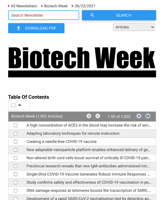←Back to resources Whether you’re a researcher, physician, or professional in the world of...
The Art and Science of the Email Newsletter
←Back to resources
We all thought email was so last decade
The year is 2018. Email is outdated. Newsletters are dead—or so we thought.
The truth is that email newsletters are just as alive as they have ever been, for email marketing as well as for informational and creative content sharing. According to the Quartz’s Global Executive Survey, 94% of top executives that check the news every day use email newsletters to get their news. Ninety-four percent!
It sounds crazy, but email newsletters are back on the rise because the world is going mobile. People have shorter attention spans, too, and the way to reach the largest number of people while demanding as little of their time as possible is via email. Email is easy to use on the go, and while we may despise cluttered inboxes, it’s a heck of a lot easier to check news and knowledge with email over visiting multiple websites, or reading newspapers.
While email marketers shy away from the outdated word “newsletter” for the sake of seeming savvy and new, the idea remains the same: in order to reach an audience, and in order to receive top content and curated news, emails are the way to go.

The Internet’s best
The Internet’s best newsletters often consist of content curation by excellent writers. Dave Pell’s NextDraft “plucks the top ten most fascinating [news] items of the day, which I deliver with a fast, pithy wit that will make your computer device vibrate with delight.” From the Desk of Austin Kleon is similarly stylish, clever, and to-the-point, featuring 10 daily inspiring stories and bits of content for creatives; both newsletters have well over 50,000 subscribers.
Meanwhile, top email marketing newsletters are fashioned similarly, offering a variety quick and to-the-point stories about their products. Unsplash, a stock-image platform, shares their favorite new photos from each day, while PlayStation’s email newsletter shows their selected top games to watch and new downloadable content.
The commonality between all these newsletters is that they share a mix of stories and content that suit differing reader tastes while using a concise format (often a list). They have strong but simple formatting and design. This style of newsletter acknowledges that in an overwhelming world of content and notifications, we’re all busy, and want to be able to easily access the content that each of us think matters most.
An AI-powered approach
All of these trends and truths from a content-inundated world inspired NewsRx’s own unique take on newsletters—the Daily.
NewsRx’s Dailies, just like top email newsletters, sends a list of personalized content to a subscriber’s email every day. What makes the Daily unique is that it uses powerful artificial intelligence and computational journalism technology to write and share original articles (as opposed to collected and curated articles). These original articles cover the top content in-demand from scientists and business professionals for scientific research, business intelligence, and product and business development.
NewsRx offers Dailies on 96 business and scientific topics. These topics cover all major business industries and areas of research for professionals, scientists, and engineers. Each Daily is a no-frills delivery of concise research news briefs that cover all of the new innovations and breaking research news on a subscriber’s chosen topic from each day. For example, NewsRx Diabetes Daily has articles that report on new and quality-checked peer-reviewed research, patents, drugs and medical devices that deal with diabetes, including company news announcements and financing details from diabetic care companies.
What NewsRx’s Dailies really bring to the table is the essential ingredient of artificial intelligence.
While AI has the potential for use in all areas of business and human life, its application in email newsletters is just as groundbreaking. NewsRx uses AI to quality-check tens of thousands of sources to eliminate inaccurate and misleading content from its Dailies—oftentimes catching inaccuracies near impossible for the human eye to spot. NewsRx’s computational journalism technology writes original one-page articles that cover all of the major points from peer-reviewed research papers and patent filings that are thousands or even tens of thousands of words long.
AI also has the potential to empower truly personalized email marketing, using AI that adapts to individual user preferences over time. A newsletter can show every user different stories and products. The application of AI to the already exciting world of mobile-friendly email newsletters revolutionizes content sharing for the 21st century, eliminating excess, low quality content, and gearing towards individual preferences.
NewsRx’s Daily is one example of how AI is transforming the art and science of the email newsletter. With the dominance and popularity of email newsletters even in 2018, we can expect to see this application and the resulting transformation in the coming years. Count on it.
Read more: What is a Daily?

.jpg?width=50&name=DSC_0028%20(1).jpg)


